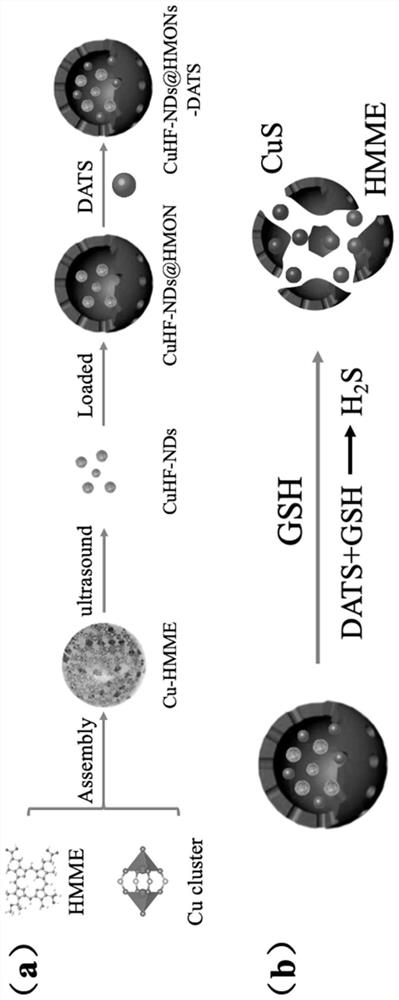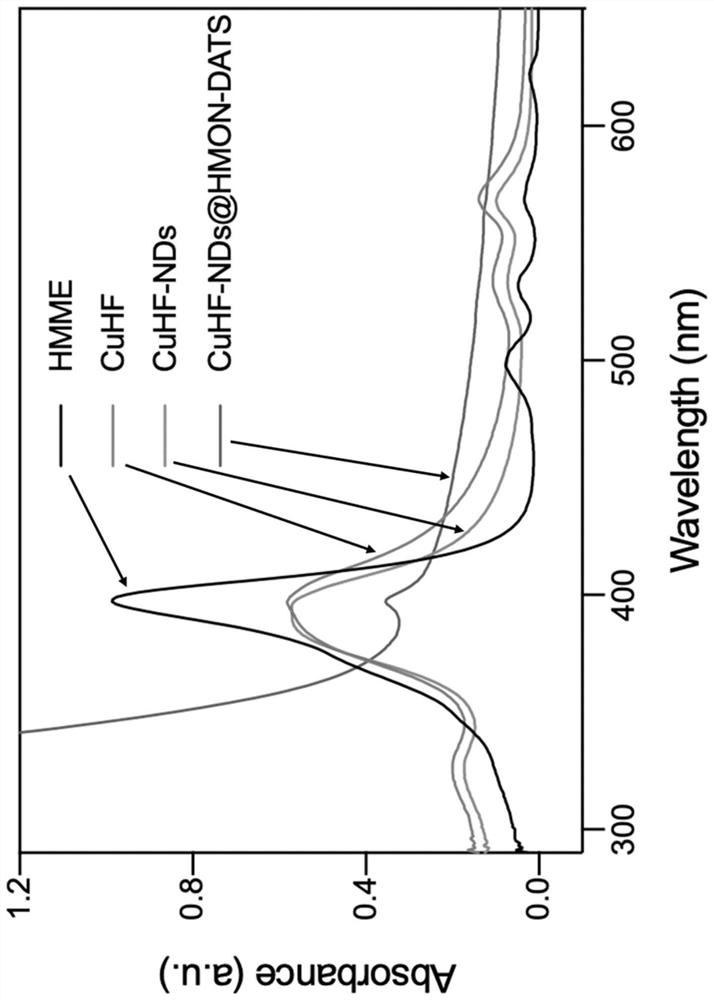Allicin-containing tumor in-situ response nano-particles as well as preparation and application thereof
A nanoparticle, allicin technology, applied in the field of nanomaterials science and biomedicine, can solve the problems of cancer damage, anticancer drugs and photodynamic therapy toxic side effects, normal tissue killing, etc., to achieve good biocompatibility, excellent tumor Therapeutic effect, excellent tumor imaging and the effect of multimodal synergistic therapy
- Summary
- Abstract
- Description
- Claims
- Application Information
AI Technical Summary
Problems solved by technology
Method used
Image
Examples
Embodiment 1
[0043] Preparation method of CuHF-NDs@HMON-DTAS:
[0044] Synthesis of Hollow Mesoporous Organic Silica (HMON)
[0045] 2 g of cetyltrimethylammonium chloride and 0.06 g of triethanolamine were sequentially dissolved in 20 mL of deionized water at 95° C. with stirring. After 20 minutes, 1 mL of tetraethyl orthosilicate was added slowly to form MSNs. After continuing the reaction for 1 hour, a mixed solution containing 1 mL of tetraethyl orthosilicate and 1 mL of bis-[3-(triethoxysilyl)propyl]-tetrasulfide was slowly added dropwise, and the resulting mixture was stirred for another 4 hours To grow the shell, the core / shell structured MSNs@MONs were collected by centrifugation. Then, the template was removed by reflux extraction three times with hydrochloric acid and ethanol solution (the volume ratio of hydrochloric acid and ethanol was 10:100, and the total volume was about 20 mL) at 75°C. Take out the MSNs@MONs solution (specifically: disperse the synthesized MSNs@MONs in ...
Embodiment 2
[0051] Absorption Characterization of CuHF-NDs@HMON-DTAS
[0052] The absorption of the material was measured by UV-vis-NIR absorption spectrometer. The results are attached figure 2 As shown, CuHF exhibits the absorption peak of HMME at 400 nm, indicating that Cu 2+ The coordination with HMME was successful. The absorption of CuHF sonicated into quantum dots CuHF-NDs showed a certain blue shift. When HMON was loaded with CuHF-NDs and DATS, it still showed an absorption peak at 400 nm.
Embodiment 3
[0054] Transmission electron microscopy (TEM) and TEM elemental scanning (Mapping) of HMON and supported CuHF-NDs@HMON-DTAS
[0055] The size and surface structure of HMON and CuHF-NDs@HMON-DTAS after loading can be determined by transmission electron microscopy (TEM, FEI Talos F200S), and the distribution of elements is determined by elemental scanning (Mapping) by transmission electron microscopy. The results are attached image 3 As shown, the HMON is mesoporous hollow (panel a) and solid when loaded (panel b), indicating successful loading of the material; elemental scans further demonstrate the loading of CuHF-NDs and DTAS (panel c).
PUM
 Login to View More
Login to View More Abstract
Description
Claims
Application Information
 Login to View More
Login to View More - R&D Engineer
- R&D Manager
- IP Professional
- Industry Leading Data Capabilities
- Powerful AI technology
- Patent DNA Extraction
Browse by: Latest US Patents, China's latest patents, Technical Efficacy Thesaurus, Application Domain, Technology Topic, Popular Technical Reports.
© 2024 PatSnap. All rights reserved.Legal|Privacy policy|Modern Slavery Act Transparency Statement|Sitemap|About US| Contact US: help@patsnap.com










